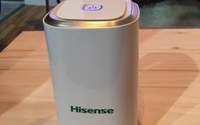Commentary
The TV Pause For A Message (And Ad?) From The Smart Appliance
- by Chuck Martin , Staff Writer, January 11, 2016
 While there are numerous smart home gadgets available or coming to
market, the idea of a totally smart home has yet to be realized at scale.
While there are numerous smart home gadgets available or coming to
market, the idea of a totally smart home has yet to be realized at scale.
Nest thermostats have been selling for some time, smart locks have been on the market for years and Samsung recently introduced their version of a smart refrigerator.
The often-stated issue, of course, is how to get all of the things of The Internet of Things to work together.
The most common current method is to convert a smartphone into a hub of sorts, to manage and coordinate connected objects.
But there will be other ways, and some of them will be far more conducive to advertising and messaging.
Though not yet available yet in the U.S., Chinese TV maker Hisense showed a rather impressive version of a connected home, one not requiring a smartphone, at CES in Las Vegas last week.
Though not yet a household name in the U.S., Hisense last year acquired Sharp America’s TV business and also got the use of the Sharp brand name in North and South America.
The Hisense smart home starts with a small hub, a small device that looks like a remote speaker and can be placed anywhere in a room.
In the detailed demonstration I saw, appliances included an air conditioning system, refrigerator and washer and dryer, in different rooms but connected via the hub.
While a person is watching TV and a wash is done, a message is sent to the TV set. Phone calls also are routed to the TV, which has been available in the U.S for some time.
However, the TV also can be used as a control point to, say, start a wash or check its status. Or to change the room temperature, turn lights on and off in different rooms and check of a door is locked, all without leaving the couch.
When a door to the house is opened, a message is routed to the TV. A smartphone also can be used, but isn’t necessary.
For CPG brands, one opportunity could be to leverage the smart knowledge from an appliance.
For example, when a clothes wash is complete and detergent is low, the message to the television viewer could include a suggestion and opportunity to one-touch, re-order the current brand detergent or try a different one suggested. The purchase would occur at the TV viewing location, via the smart home hub.
This system is currently only available in Asia but obviously is targeted ultimately to expand to the U.S.
The logical progression is not necessarily for a homeowner to go purchase a house full of smart appliances to create their smart home.
More likely will be that each appliance purchased moving forward will be a smart appliance, whether a consumer wants a smart one or not.
But at least in the case of the Hisense approach, once a smart home hub is added, the appliances instantly become the foundation of the smart home.
And the TV advertising of The Internet of Things then can run on the TV while TV programming – and commercials – are paused.




That's all I need. So, if I'm using my electric shaver in the morning I'll suddely get a commercial for a razor blade or a shaving lotion on my TV set, smartphone or tablet---- or all three at once. Whoopie!
Not sure that's the way it will roll out, Ed. Consumer reactions wil certainly play a major role in what does and does not come through the screen and when.